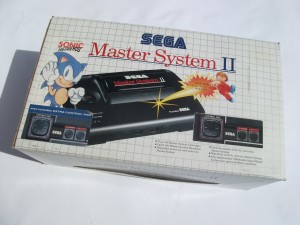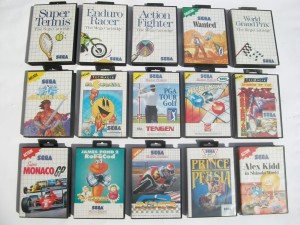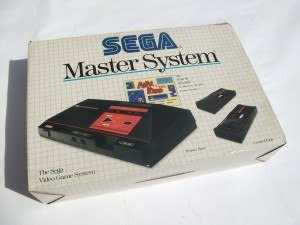In 1987, Sega brought us their third generation video game console in the form of the Sega Master System. This is one of those systems that it like purely for its simplicity, the pads are small basic, simple buttons. The console has two controller ports at the front for the pads and an off/on switch.
In total three version were released. The Master system I in Japan in 1987, the Sega Master System II in 1990 and the Master System III was released in Japan on Sunday, October 20, 1985.
The system fell straight in the firing line of the Nintendo Entertainment System and went down a similar path as Nintendo providing such add-ons as a Light Phaser Gun, varied controllers and even boasting 3D Glasses with an adapter card. With a library of some 318 games, what more could you ask for! Due to strong international support, the Master System became the second best selling Sega console with 13 million units being sold worldwide. I suppose that i why in 2009, the Master System was named the 20th best video game console of all time (out of 25) by the video gaming website IGN ( would have liked to have seen it a little higher ).
The Master System II was basically a low-cost Master System that lacked several of the original’s features.
The latest version is the Master System III (a completely different unit to the original “Master System III” which was a grey Master System II) released by Tec Toy. It has a brand new modern black design, with details in blue. Even with the visual changes, it was not renamed, save switching the roman number in the name to a decimal number. Although outwardly similar to the Master System II, the Master System III featured internal changes that allowed it to handle cartridges up to 8 megabits (kilobytes) in size.
The Sega Mark III was released in Japan on Sunday, October 20, 1985 at a price of ¥15,000 as a competitor to Nintendo’s Family Computer.
Games for the console came in two formats; ROM cartridges and Sega Game Cards. The cards held only 256 kilobits of data (cartridges held at least 4 times that amount, e.g. the early “mega cartridge” games with 1 mbit / 128 kbit), but were cheaper to manufacture and sold for less than the carts did. The console also featured games built into the system BIOS that played whenever a cart or card was not inserted; the different models of the console each featured different built-in titles. The Mark III was also backwards compatible with SG-1000 software.
The controller uses the prevailing de facto standard Atari-style 9-pin connector and can be connected without modification to all other machines compatible with that standard, including the Atari 2600, Commodore 64, ZX Spectrum with Kempston Interface, Commodore Amiga and the Atari ST.
The console was redesigned several times both for marketing purposes and to add more features. The later Sega Game Gear is effectively a hand-held Master System, with a few enhancements.
The Sega Master System was re-released in late 2006 under several brands including Coleco and PlayPal. This small handheld device is powered by 3 AAA batteries, it also came with a bright active matrix screen, and contained 20 Game Gear and Sega Master System games built-in.
The last licensed release in Japan was Bomber Raid, released by Sega on February 4, 1989.
Sega-Scope 3-D Glasses
Basically the left and right lenses of the LCD shutter glasses are opaque, so rapidly alternating between them in tandem with two different alternating images flashed from the TV and synchronized with the switching of the 3-D Glasses made it possible to create a natural stereoscopic 3D effect. However the Sega Scope 3-D glasses can only be used with the original Master System, since it hooks up directly to the card port (not found on the master system II) and this allows 3-D graphics in full colour to be possilbe. The technology takes advantage of the interlaced video output of contemporary CRTtelevisions, displaying the left image in the top field and the right image in the bottom field. Only eight Master System games are 3-D compatible.
the switching of the 3-D Glasses made it possible to create a natural stereoscopic 3D effect. However the Sega Scope 3-D glasses can only be used with the original Master System, since it hooks up directly to the card port (not found on the master system II) and this allows 3-D graphics in full colour to be possilbe. The technology takes advantage of the interlaced video output of contemporary CRTtelevisions, displaying the left image in the top field and the right image in the bottom field. Only eight Master System games are 3-D compatible.
- Blade Eagle 3-D
- Line of Fire (hold buttons 1 and 2 while switching the system on for 3-D mode)
- Maze Hunter 3-D
- Missile Defense 3-D (also requires the Light Phaser gun)
- Out Run 3-D (can also be played in 2-D mode without glasses)
- Poseidon Wars 3-D (can also be played in 2-D mode without glasses)
- Space Harrier 3-D (can also be played in 2-D mode without glasses via a code)
- Zaxxon 3-D (playable in 2-D via a code)
With the use of the Power Base Converter, all peripherals are fully compatible with the Sega Mega Drive.
Light Phaser Gun
The Light Phaser was basically a light gun specifically created for the Sega Master System, modeled after the Zillion Gun from the Japanese anime series of the same name. The phaser was heavier than its Nintendo counterpart, the Nintendo Zapper, but considered by some to have a more responsive trigger and more accurate targeting. As with the Japanese-market Nintendo Zapper, the Light Phaser looked realistic enough to warrant parental pressure to alter the device so that police would not confuse it with a real gun. Altered Light Phasers are distinguished by a hand-painted neon orange tip and are much rarer than their solid color counterparts. Tec Toy also released a blue Light Phaser in Brazil.
Quite a few games in development for the Master System that were specifically for use with the Light Phaser Gun other than the following:
- Assault City
- Gangster town
- Laser Ghost
- Marksman shooting
- Missile Defence 3-D
- Operation Wulf
- Rambo III
- Rescue Mission
- Safari Hunt
- Shooting Gallery
- Space Gun
- Trap Shooting
- Wanted
There are two versions of Assault City; the other version can also be played with a gamepad
TOP TIP
On the original release of the Master System, a hidden game known as Snail Maze is built in the console, which was a number of labyrinth puzzles with a time limit. This game can be accessed from the system BIOS by starting the system without a game cartridge inserted and holding Up and buttons 1 and 2 simultaneously on the game pad.
Technical specifications
- CPU
- The Master System’s CPU is a 8/16-bit Zilog Z80. The maximum addressable memory is 64 KB.
- Video
- Graphics: VDP (Video Display Processor) derived from Texas Instruments TMS9918A
- Up to 32 simultaneous colors available (one 16-color palette for sprites or background, an additional 16-color palette for background only) from a palette of 64 (can also show 64 simultaneous colors using programming tricks)
- Screen resolutions 256×192 and 256×224. PAL/SECAM also supports 256×240
- 8×8 pixel characters, max 463 (due to VRAM space limitation)
- 8×8 or 8×16 pixel sprites, max 64
- Horizontal, vertical, and partial screen scrolling
- Audio
- Sound (PSG): Texas Instruments SN76489 (note that the Sega Master System, Game Gear, and Mega Drive used a slightly altered clone of the newer SN76489A, while the older SG-series used the original SN76489)
- 4 channel mono sound (3 Square Waves, 1 White noise)
- 3 tone generators, 10 octaves each, 1 white noise generator
- Sound (FM): Yamaha YM2413
- Mono FM synthesis
- Switchable between 9 tone channels or 6 tone channels + 5 percussion channels
- Included as a built-in “accessory” with the Japanese Master System (1987)
- Supported by certain games only
- Onboard RAM
- Boot ROM: 64 kbit (8 KB) to 2048 kbit (256 KB), depending on built-in game
- Main RAM: 64 kbit (8 KB), can be supplemented by game cartridges
- Video RAM: 128 kbit (16 KB)
- Game Card slot (not available in the Master System II)
- Game Cartridge slot (not included on newer Brazilian models, as these have built-in games)
The difference in cartridge style is a form of regional lockout
-
- Japanese and South Korean consoles used 44-pin cartridges, the same shape as SG-1000 cartridges
- All other consoles use 50-pin cartridges with a wider shape
- Expansion slot
- Unused, pinout compatible with 50-pin cartridges (but opposite gender) in all regions
